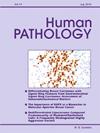Clinicopathological and molecular genetic insights into EBV-positive inflammatory follicular dendritic cell sarcoma
IF 2.7
2区 医学
Q2 PATHOLOGY
引用次数: 0
Abstract
Epstein-Barr virus (EBV)-positive inflammatory follicular dendritic cell (FDC) sarcoma (EBV + IFDCS) is a rare entity, and its histopathological characteristics have not been fully described. This study aimed to investigate the clinical characteristics, pathological features, and molecular genetic profiles of EBV + IFDCS to improve our understanding of these lesions. A total of 12 EBV + IFDCS specimens were obtained from patients in our pathology diagnostic center. The clinical data, morphology, immunohistochemistry, in situ hybridization, and high-throughput DNA-targeted sequencing data were collected, and follow-up data were analyzed. These data were compared with those of 6 patients with traditional FDCS. The patients with EBV + IFDCS ranged from 21 to 84 years old, with a mean age of 52.3 years and a male-to-female ratio of 1:5. At the last follow-up, all patients were alive, with 2 experiencing recurrence and metastasis. In these cases, four were classified as the classical subtype, four as the angiomatoid/sclerosing subtype, and four as the lymphoma-like subtype, with two cases also exhibiting epithelioid granulomas. All patients exhibited heterogeneous expression of follicular dendritic cell markers (CD21, CD23, CD35, and CXCL13) alongside the fibroblast marker SMA, with significantly higher expressions of IgG4, EBER, and SMA in EBV + IFDCS patients compared to FDCS patients (P < 0.05). Conversely, SSTR2, EGFR, and STAT3 expression were significantly lower in the EBV + IFDCS group (P < 0.05). The average value of EBER was significantly higher in the classical subtype group (P = 0.022). Among the four cases of EBV + IFDCS analyzed for molecular genetic features, one patient exhibited germline mutations in the CDKN1C, PDGFRA, MSH2, FANCG, MLH1, ALK, and RUNX1 genes; three exhibited simultaneous SNP variations in the MTHFR gene; and two exhibited simultaneous SNP variations in the NQO1 gene. We conducted KEGG pathway analysis on the mutant genes, revealing significant enrichment in the cAMP signaling pathway, which plays a crucial role in tumor development. Survival analysis demonstrated that the median PFS rates were not reached (NR) for EBV + IFDCS patients, compared to 5 months (HR = 7.76) for FDCS patients. The 3-year PFS rates were 66.67% and 16.67%, respectively. Compared with the FDCS group, EBV + IFDCS patients had a significantly longer median PFS time (p < 0.05). In conclusion, EBV + IFDCS represents a group of tumors with unique clinical, morphological, immunological, prognostic, and molecular cytogenetic characteristics.
对 EBV 阳性炎性滤泡树突状细胞肉瘤的临床病理和分子遗传学见解。
爱泼斯坦-巴氏病毒(EBV)阳性炎性滤泡树突状细胞肉瘤(EBV+ IFDCS)是一种罕见病,其组织病理学特征尚未得到充分描述。本研究旨在调查EBV+ IFDCS的临床特征、病理特征和分子遗传学特征,以加深我们对这些病变的了解。我们的病理诊断中心共从患者身上获取了 12 份 EBV+ IFDCS 标本。我们收集了临床数据、形态学、免疫组化、原位杂交和高通量DNA靶向测序数据,并对随访数据进行了分析。这些数据与 6 例传统 FDCS 患者的数据进行了比较。EBV+ IFDCS患者的年龄从21岁到84岁不等,平均年龄为52.3岁,男女比例为1:5。在最后一次随访中,所有患者均存活,其中 2 例患者出现复发和转移。在这些病例中,4 例被归为典型亚型,4 例被归为血管瘤样/硬化亚型,4 例被归为淋巴瘤样亚型,其中 2 例还表现为上皮样肉芽肿。所有患者都表现出滤泡树突状细胞标志物(CD21、CD23、CD35 和 CXCL13)与成纤维细胞标志物 SMA 的异质性表达,与 FDCS 患者相比,EBV+ IFDCS 患者的 IgG4、EBER 和 SMA 表达明显更高(P<0.05)。
本文章由计算机程序翻译,如有差异,请以英文原文为准。
求助全文
约1分钟内获得全文
求助全文
来源期刊

Human pathology
医学-病理学
CiteScore
5.30
自引率
6.10%
发文量
206
审稿时长
21 days
期刊介绍:
Human Pathology is designed to bring information of clinicopathologic significance to human disease to the laboratory and clinical physician. It presents information drawn from morphologic and clinical laboratory studies with direct relevance to the understanding of human diseases. Papers published concern morphologic and clinicopathologic observations, reviews of diseases, analyses of problems in pathology, significant collections of case material and advances in concepts or techniques of value in the analysis and diagnosis of disease. Theoretical and experimental pathology and molecular biology pertinent to human disease are included. This critical journal is well illustrated with exceptional reproductions of photomicrographs and microscopic anatomy.
 求助内容:
求助内容: 应助结果提醒方式:
应助结果提醒方式:


